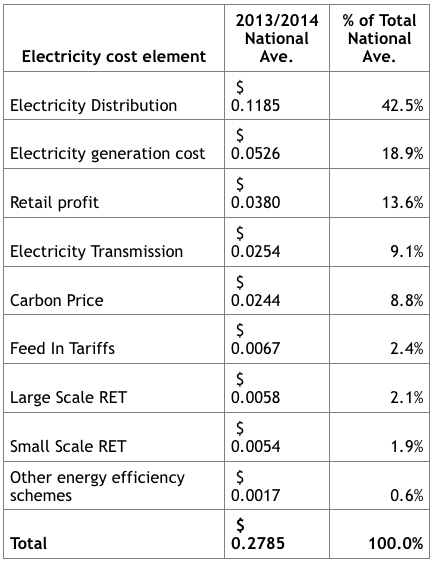The newspapers are full of stories about electricity costs and it’s no wonder because prices have increased by as much as 33% in some states in the last three years.
Many people we talk to say to us: “We don’t understand – we have reduced our energy consumption, use energy efficient appliances and yet our bill keeps rising. What’s going on?” The simple fact is that with national average costs now hovering around $0.28c kWh, you have two choices – change your supplier or reduce your demand even more.
Recent reports show that changing from a regulated tariff to a market offer tariff, which essentially means shopping around and signing up to a new contract which could save between 3% and 16% depending on what you have and what you are eligible for. However, for many, signing up to long term contracts or complex new deals for to save just a few percent is simply not attractive.
Installing solar power is one alternative than millions of Australians have turned to.
Depending on where you are located and what tariff you are on, a solar system will generate electricity for between $0.10-$0.20c kWh. So one thing is crystal clear – as a homeowner, solar will generate electricity cheaper than you can buy it in almost every case.
The average home uses around 20kWh of electricity a day. In simple terms, the average solar system size in Australia is currently around 3.5kW and this will generate around 13.5kWh/day on average and thus – almost 70% of the average electricity bill.
Although there is very little value for excess energy (exported to the grid), a well matched solar system will offset your demand (replacing bought energy with self-generated energy) and if you are paying $0.28ckWh then you will effectively get this rate for your own solar energy. Nice.
So even without feed-in tariffs, solar still makes huge sense. The Renewable Energy Target (RET) is the main scheme currently in place and via your solar supplier typically provides an up-front discount of around 20-30% off the capital cost. Great!
Recently, there have been a number of media stories about the fact that there are now more than 1 million solar homes in Australia, many of whom received financial support through feed-in tariffs and the Renewable Energy Target. These programs have been very successful at creating employment, increasing the use of solar energy and decreasing the carbon intensity of Australia’s energy mix.
Some of these news stories blame the solar support programs for being the main driver of increasing electricity prices. Is this true?
As the table below from the AEMC report shows, the small-scale RET, which is the primary solar support mechanism, contributes a mere 1.9% to the national average bill and it is declining. Feed-in tariffs add another 2.4% but are also declining and in some states will end in the near future. So, it is pretty clear to see that solar isn’t the main culprit and in fact, has recently demonstrated that it is helping to ease the pressure of peak electricity demand on sunny days.
Solar isn’t a silver bullet solution but it can help millions of Australian householders reduce their costs in an economical way and on the whole, costs the wider community very little indeed.
 Some quick solar facts:
Some quick solar facts:
- By the end of 2014 around 28% of Australia’s 8.2Million homes will use solar energy
- More than 50% of Australian homes are ideally suited to solar energy (4.8Million)
- Assuming an average 1.8 voting age Australians live in each of these homes, more than 4.1Million Australians live with solar energy every single day
- Australia’s National energy generation capacity is around 50GW (mostly coal). Installed solar energy capacity is now around 3GW (that’s 3 billion watts!) or about 6% of capacity.
© 2014 Solar Choice Pty Ltd
- Should you oversize Solar Panels to your Inverter? Pros and Cons explained - 3 February, 2017
- Lithium what? Know your Lithium Ion battery technologies - 28 May, 2014
- Government attacks Australian solar SMEs - 26 May, 2014
Hi Nigel,
The above arguments are leading us to inevitable use of energy storage equipment.
The ROI period of solar installations with storage capabilities will shorten as prices of storage plummets. We’ve seen this before with PV components.
German policymakers are in their second year of introducing incentives for storage capacity, thus encouraging grid independence. Subsidy reaches up to 600 Euro/kW for use of own electricity.
I’m not arguing with you about employment issues here. Probably RET abolishment is not good for traditional solar industry but things change and industries pivot or evolve in more complex business model.
Couldn’t agree more! Storage is evolving very rapidly but prices in our unsubsidized storage market are still very challenging. But it will definitely come and I suspect, sooner than most expect.
-Nigel